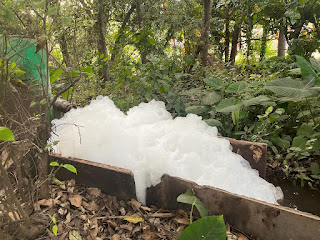Module-3 Organic farming and Waste management
MODULE-3
ORGANIC FARMING AND WASTE MANAGEMENT
Organic agricultural methods are internationally regulated and legally enforced by many nations, based in large part on the standards set by the International federation of orgainic agricultural movements (IFOAM), an international umbrealla organization for organic farming organizations established in 1972. Organic agriculture can be defined as "an integrated farming system that strives for sustainability, the enhancement of soil fertility and biological diversity while, with rare exceptions, prohibiting synthetic pesticides, antibiotics, synthetic fertilizers, genetically modified organisms, and growth hormones".
Since 1990, the market for organic food and other products has grown rapidly, reaching $63 billion worldwide in 2012. This demand has driven a similar increase in organically-managed farmland that grew from 2001 to 2011 at a compounding rate of 8.9% per annum.
As of 2020, approximately 75,000,000 hectares (190,000,000 acres) worldwide were farmed organically, representing approximately 1.6% of total world farmland.
Roses are erect, climbing, or trailing shrubs, the stems of which are usually copiously armed with prickles of various shapes and sizes, commonly called thorns. The leaves are alternate and pinnately compound (i.e., feather-formed), usually with oval leaflets that are sharply toothed. The flowers of wild roses usually have five petals, whereas the flowers of cultivated roses are often double (i.e., with multiple sets of petals). Rose flowers’ size ranges from tiny miniatures 1.25 cm (0.5 inch) in diameter to hybrid flowers measuring more than 17.5 cm (7 inches) across. The rose plants fleshy, sometimes edible, berrylike “fruit” (actually the floral cup) is known as a hip and usually ranges from red to orange in colour.
Abutilon megapotamicum or Callianthe megapotamica ( trailing abutilon) is a species of Abutilon native to Argentina, Brazil and Uruguay. It is a shrub growing to 2.5 metres (8 ft 2 in) tall, with leaves 5–8 centimetres (2.0–3.1 in) long, ovate to shallowly three-lobed.The flowers of the damsak rose and several other species are the source of attar of roses used in perfumes. Many species, particularly the rugosa rose produce edible rose hips, which are a rich source of vitamin C and are sometimes used in preserves.
There are several major classes of garden roses. The best-known and most-popular class of rose is that of the hybrid tea roses, which accounts for the majority of roses grown in greenhouses and gardens and sold in florist shops. Hybrid teas come in the complete range of rose colours and have large symmetrical blossoms. Hybrid teas resulted from the crossbreeding of frequently blooming but fragile tea roses with vigorous hybrid perpetual roses. The hybrid perpetuals achieved great popularity until they were supplanted by the hybrid teas in the early 20th century. Polyantha roses are a class of very hardy roses that produce dense bunches of tiny blossoms
Jasmine is a genus of shrubs and vines in the olive family of Oleaceae. It contains around 200 species native to tropical and warm temperate regions of Eurasia, Africa, and Oceania. Jasmines are widely cultivated for the characteristic fragrance of their flowers. A number of unrelated plants contain the word "jasmine".
Conclusion: Organic farming yields more nutritious and safe food. The popularity of organic food is growing dramatically as consumer seeks the organic foods that are thought to be healthier and safer. Thus, organic food perhaps ensures food safety from farm to plate. The organic farming process is more eco-friendly than conventional farming.












Comments
Post a Comment